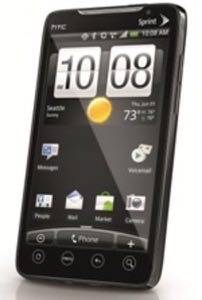You may have heard that a little company called Apple will be announcing, among other things, a new iPhone today. Supposedly called the “iPhone 4” (or maybe the “iPhone 4G? HD?”), for the first time ever since the product’s initial debut, news of the company’s latest gadget may not be met with same levels of adoration granted to Apple’s previous announcements – and not just because photos of a stolen iPhone prototype spoiled us by giving away all Apple’s secrets in advance.

No, today Apple is finally facing some tough competition in the smartphone space from none other than its former friend and partner Google, whose Android mobile operating system can now be found on a range of devices including the new must-have phone, the EVO, as well as the Droid, the Nexus One and more.
In a matter of hours, we’ll find out if the iPhone can still compete.
Android Riding High
Sprint’s launch of the first 4G Android phone has already been met with success, according to the latest company news. Via a morning press release, Sprint is announcing that the total number of HTC EVO 4G devices sold on launch day was three times the number of Samsung Instinct and Palm Pre devices sold over their first three days on the market combined.

The announcement also claims the demand for the device has led to some “temporary shortages” at some of the 22,000 Sprint stores across the U.S., which Sprint certainly thinks is a badge of honor. “We have a sold-out phone!”, they’re practically crying.
But the reason for the EVO’s success isn’t just the innovative features of the device itself, it’s the operating system powering it. Google’s Android OS has succeeded by offering what Apple doesn’t. For one thing, Android’s app store is wide open. Apps don’t go through lengthy review processes – they’re instantly published to the Android Market. The OS is also available to multiple carriers on multiple hardware form factors at multiple price points. You can get the kind of phone you want (keyboard, no keyboard, size, weight, screen resolution, etc.) while still enjoying the Android experience.
Steve Jobs Should Announce:
But even more importantly, Android offers things the iPhone doesn’t. If Apple wants to compete, here’s what Steve Jobs needs to announce today.
1. Better Tethering
The current version of the Android OS, version 2.2 (code-named “froyo”), offers both USB and Wi-Fi tethering, the latter of which may be operator-controlled. With this feature, already available on the EVO thanks to Sprint’s own offering, your phone becomes an instant Wi-Fi hotspot for neighboring devices. Apple had to delay a tethering feature until now because they’re dependent on AT&T, a network that hasn’t quite been up to par with its competitors as of yet. It simply couldn’t support the data load of tethering.

But now AT&T has announced new data plans, one of which offers a tethering option for $20 extra per month. But wait – there’s a catch (besides the fee, that is). The iPhone can’t be tethered with the iPad, so no free data for you Wi-Fi iPad users. Why? According to AT&T, it’s an issue with Apple software. The iPad doesn’t have USB ports, a spokesperson told the tech news site TechFlash. And iPad Bluetooth tethering is still a no-go.
2. Video iChat/Front-Facing Camera
With EVO’s launch came the first mainstream video chat/video calling application, Qik. Joining Fring – and perhaps soon, Skype – Qik’s video chat application for Android lets EVO users make video calls to other EVO users, and soon to others who have supported Android handsets (those with front-facing cameras.) It’s not enough for Apple to simply launch a front-facing camera at this point and let the third-party apps do the work. If Apple wants to one-up Android, the company needs its own specialized mobile iChat service that integrates with its lineup of other Apple apps, including its mobile mail, contacts and calendar. A cohesive digital office offering which includes iChat as a feature could trump standalone apps for those who have invested in Apple’s ecosystem.
3. Free MobileMe
For users of Google services, going Android just makes sense. Gmail is one of the world’s most popular webmail programs, and its deep integration, along with contacts, calendar and other Google offerings, into the Android mobile OS make the phone a powerhouse for Google users. Apple has a shot at doing something similar with its MobileMe collection of services, but unlike Google, Apple charges hefty fees to use them. Google gives away its basic services for free, while businesses and other advanced users can upgrade to Google Apps for a fee. Apple should copy Google’s freemium plan with a free entry-level version of MobileMe if it wants to compete as a services company, too.

4. Wi-Fi Sync
iTunes is an old, clunky behemoth in desperate need of an overall. Let’s make this absolutely clear: Zune HD has done Wi-Fi sync from day one. Yes, that’s right, Microsoft’s Zune. Day one. Why can’t Apple do this? Answer: because they didn’t have to. Zune wasn’t a competitor. But now Android is and has plans for Wi-Fi sync. That means Apple needs to fix the iTunes situation.
Google is working on over-the-air music downloads with automatic sync, according to Google’s VP of engineering, Vic Gundotra. Announced at Google’s recent I/O conference, the updated Android Market (“coming soon,” said Gundotra), will let you download both apps and music over-the-air, the same as with Apple’s iTunes and mobile app store, but with a twist: automatic OTA updates.
Apple, better do something with that Lala.com acquisition, quick!
These are just a few of the things we’re hoping Apple announces today at the upcoming event. Hopefully, the company will continue to surprise us as it has in the past, making the choice between iPhone and Android a tough one.

















